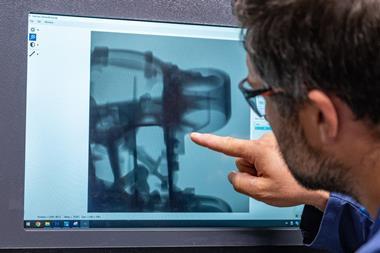Sogefi’s plant in Tredegar, Wales, produces complex fuel and air filtration systems and boasts an impressive array of manufacturing technologies
 On the edge of the Welsh valleys, a few miles north of Cardiff, is the quiet location for a hive of automotive manufacturing activity. According to Chris Jones, plant director at Tredegar, the facility manufactures a mixture of fuel and air filtration systems for passenger car, commercial and off-highway vehicles, covering 1,200 different products in 500 unique product families.
On the edge of the Welsh valleys, a few miles north of Cardiff, is the quiet location for a hive of automotive manufacturing activity. According to Chris Jones, plant director at Tredegar, the facility manufactures a mixture of fuel and air filtration systems for passenger car, commercial and off-highway vehicles, covering 1,200 different products in 500 unique product families.
The 15,000 sq.m factory has a workforce of around 300 employees and operates an unusual shift pattern, working a four-day week (Monday to Thursday, 9.25 hours per day). If increased demand requires, it will run a twilight shift from 4.45pm to 9.15pm and a night shift from 9.15pm to 7am. In addition to the standard four-day week there are three 12-hour shifts over Friday, Saturday and Sunday, with the option for a weekend night shift that can be added if needed. Jones said this shift structure offers a lot of flexibility in production, allowing for the peaks and troughs of demand.
Manufacturing operations are surprisingly vertically integrated with plastic injection moulding and steel pressing performed on-site along with the assembly and test processes. Jones offers a Nissan Qashqai air intake system as an example, explaining that the plant produces the complete unit, utilising its 18 injection presses for the plastic components with the only part outsourced being a section of rubber ducting and some small fixings.
Complex products and processesWhat also becomes clear is the complexity of both the products and processes required to produce them. Jones highlighted the manufacturing processes used to incorporate a priming pump and heater in a diesel filter system, the later part requiring the application of a sophisticated laser welding process. He noted that this was unusual in that, instead of the laser being used to heat two parts that would be subsequently pressed together, this manufacturing process used plastic components that have a very specific, critical translucency, which allows the light transmission from the laser to pass through and weld the underside of the disc to another plastic part beneath it. This is a critical process to ensure no contamination or leakage occurs.
Jones pointed out that safety is the number one priority for Sogefi at its manufacturing facilities, and that the plant had achieved significant year-on-year reduction in workplace accidents though improved working practices. Workers are encouraged to report any safety-related incidents or ‘near misses’ as, Jones noted, these could be potentially future serious accidents. Another example is the use of monthly behavioural audits that monitor how the workforce is operating and thinking in relation to safety in the factory.
Efficiency has also improved through the use of layered process audits (LPA). These weekly audits check that all production sections are working to the quality control plans and they alternate between different operations within each section. In addition, the company is now implementing quick-response quality control (QRQC). These ‘tools’ are applied to process and safety issues.
Any concerns regarding operations are noted on a ‘QRAP’ board located in the relevant section; once something is added to the board, the area supervisor must contact the relevant teams, implement the necessary investigation and ensure the issue is resolved satisfactorily. All actions and the dates they took place are recorded on the board. This very transparent process ensures that a quick response to any issue.
Another visible process is ‘red tagging’; if a worker identifies a problem or notices something worn or not performing properly, they attach a red tag to the machine or component to visibly tag the issue for the attention of the maintenance teams.
Jones acknowledged he was initially sceptical that such processes would be so effective, but he is now “100% convinced’ of the positive impact they have had on quality and productivity. He noted that the plant now has an impressive defect rate of less than one part per million. In fact, he says: “We’re now working in a defect range of parts per billion! And that figure is currently below 1 ppm.”
Although the automotive industry is offering its customers more choice in terms of trim and equipment options, OEMs are rationalising their engine line-ups and this protects Sogefi from too much variation and change in the demands on its manufacturing operations. However, Jones pointed out that filtration and cooling systems have had to adapt to new fuels and coolants. One example cited is bio-fuels; although claimed to be better for the environment, they can have an adverse affect on filter housings. Jones explained that some of the company’s diesel filter housings require the application of an aluminium coating to protect the casing from the corrosive nature of the bio-fuel. Similarly, rubber gaskets have been replaced by more expensive and chemical-resistant fluoroelastomer-based seals.
Tredegar operates a lean process and, depending on the supplier and the component, the plant tries to get parts delivered in tote bins, which don’t require unpacking and can then quickly and easily be transferred from the holding area to an electric transport that circles the production areas delivering the totes to the relevant station. The transport delivers 20 minutes worth of parts to each station on the line; when it has completed all the drops it returns to the holding area to collect the next batch of parts. Jones said this continuous process means there is a minimal amount of materials on the line side at any one time.
Cleanliness and qualityA tour of the production operations included the clean room, a sealed environment for the assembly of diesel filter systems. The levels of complexity mentioned earlier are clear to see in this section. Seemingly small, simple operations are performed with extreme care; a small, but crucial, earth pin is manually loaded into the machine for automatic assembly into position, a sophisticated vision system then checks that there is a very small O-ring in position; vital to ensure correct sealing of the filter housing. The production operations in this section make use of a high number of automated vision systems performing quality control checks throughout the process, with some assembly operations requiring more than one vision inspection.

There is a very strong focus on quality control throughout and Jones noted that visual checks by the assembly workers are not enough on their own. Once assembled, the filter systems are checked by filling with air, which has to be allowed to stabilise; then the filters are pressurised and checked for leaks. Jones said this test is the bottleneck on this particular line, but is something that has to be done and can’t be speeded up. “We operate on a one-piece flow for quality control reasons. We want to avoid having partially assembled filters stacking up at the stations as this is where problems can occur,” he explained.
The assembly operations are an interesting combination of labour-intensive jobs combined with sophisticated automation equipment. With many small parts requiring assembly there is a great attention to detail in the manual processes to ensure the operators can quickly and efficiently assemble the parts without error.
2018 will see further large investment being made to increase automation levels in this area, according to Jones. However, efficiencies can be made in other less costly ways. Jones said that as part of the Sogefi Excellence System (SES) the company carries out a POP analysis where the work flow is timed and monitored at different stations to see if there are any imbalances in the flow. “It is surprising how much this type of process opens your eyes and what can be achieved without the need for large investments,” he noted. In one example cited, the outcome of a Hoshin workshop highlighted the benefits of reducing the package sizes of parts delivered to the line and changes to equipment layout. The implementation of these findings resulted in a 33% improvement in the productivity of that cell and a 25% reduction in the floor space needed.
Another daily quality/productivity procedure involves a 15-minute, level one maintenance. Jones explained that this involves stopping the line, and then the operators clean and check the equipment ensuring everything is functioning properly and no defects are being produced that might be passed on the next shift.
Promoting preventative maintenanceA big factor in maintaining a very low defect rate is in the training of the staff. Jones explained how important it is that the operators achieve a good ‘rhythm’ to avoid ‘stop-start’ issues. He noted that even though the automated processes are very efficient, resetting systems is very time consuming, which is why SMED workshops are key to continuing to reduce changeover times. As such new employees undergo an average of two weeks training, depending on the section they will be working on. In addition a very proactive approach is encouraged across the plant to promote a culture of preventative maintenance among the workforce; Jones stated that 85% of the maintenance carried out in the plant is preventative.
Maintaining the high tempo of quality and productivity at Tredegar requires a process of constant improvement and Jones noted there is large annual investment in new equipment and technology to keep the plant competitive. Most recently, a new chevron pleating line (for the paper filter media) has been installed along with a new 850-ton press for the future production of inlet manifolds.





































